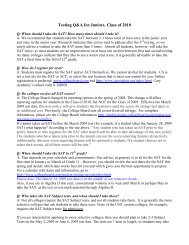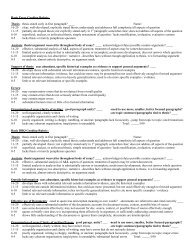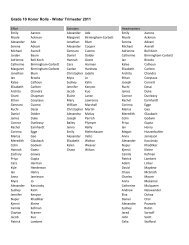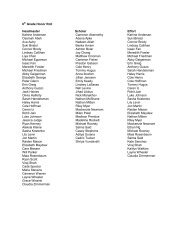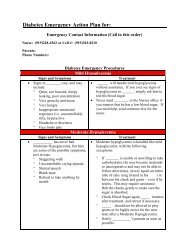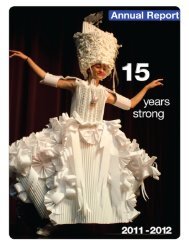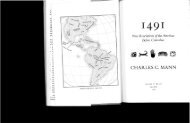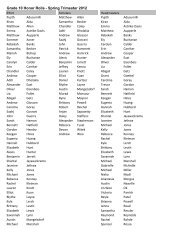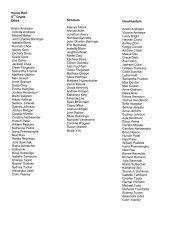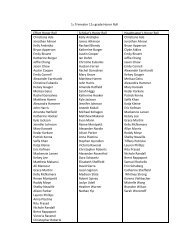TREASURE AND TREATY Ma Huan, 1413-1431 CE - Cary Academy
TREASURE AND TREATY Ma Huan, 1413-1431 CE - Cary Academy
TREASURE AND TREATY Ma Huan, 1413-1431 CE - Cary Academy
Create successful ePaper yourself
Turn your PDF publications into a flip-book with our unique Google optimized e-Paper software.
7~<strong>TREASURE</strong> <strong>AND</strong> <strong>TREATY</strong><strong>Ma</strong> <strong>Huan</strong>, <strong>1413</strong>-<strong>1431</strong> <strong>CE</strong>~/,-,,"'1r1-/ e.. e116CJt.v,ia., "AUt:J5e5' T-"'--- ~J I:uo"~ 10 upturi.-'n..14J3 <strong>CE</strong>o a Ming Chinese fleet of perhaps fifty-seven vesselssomemore than 200 feet long-sailed majestically out of theIshipyards associated with Nanjing, the imperial capital. The largestvessels were termed "treasure ships" for the vast quantities of Chinesegoods they carried and the treasures they brought back in-trade and tribute from faraway places. In the fleet were ships thatc;arri@Q an army of more than 20,000 fighting men, ships forh.orses, and ships that carried only water. 1 After more than a yearof preparation, the fleet slowly made its way east 200 miles downthe Yangtze River to the Yellow Sea. 2 It was commanded by ZengHe, a highly placed and powerful court eunuch and confidant ofthe emperor. z"-~'/) ~ ~ nuu..t::~As the fleet sailed from Nanjing, among those aboard was.<strong>Ma</strong><strong>Huan</strong>, recruited "in a subordinate capacity as a translator of foreigndocuments."3 lje was thirty-two years old, Muslim, andspoke and read Arabic 4* <strong>Ma</strong> <strong>Huan</strong> was from a city a few milessouth of Hangzhou, one of the major trading ports of the timeand about 150 miles south of the Nanjing shipyard. He was no*<strong>Ma</strong> <strong>Huan</strong> may have belonged to a village that was predominantly or completelyMuslim, which seems to have been the common pattern. Muslim villagestended to locate along trade routes and center on a single local mosque.117
118 <strong>TREASURE</strong> <strong>AND</strong> <strong>TREATY</strong>noble or courtier, but rather a simple man, perhaps a low-levelofficial. He self-deprecatingly describes himself as a "mountainwoodcutter."5Like the rest of the men aboard, he would be awayfrom his home and family for more than two years. <strong>Ma</strong> <strong>Huan</strong>'smemoir is particularly important because it is one of only twosurviving eyewitness accounts of these imperial fleets and theirvoyages.By the time of <strong>Ma</strong> <strong>Huan</strong>, Chinese goods had already circulatedthrough Southeast Asia and the Indian Ocean for centuries.R.~ill that Chinese goods formed much of the cargo of the tenthcentury Intan shipwreck featured in Chapter 3. Chinese shipsdid not, however, venture west of the <strong>Ma</strong>lay Peninsula. Even inthe thirteenth century, Abraham bin Yiju, the Jewish spice trader,recorded no Chinese fleets during his twenty years of residenceon the <strong>Ma</strong>labar Coast ofInd;a. ~[Something rather new happened in the late thirteenth century.The Mongols, under a grandson of Genghis Khan. conq.uered allof China in 1279 <strong>CE</strong>o Scholars still hotly debate how much theMongols adopted Chinese customs and how much they influencedChina! The Mongol invasions effectively closed any dividebetween North and South China." The Mongols sent expeditionsof conquest into mainland Southeast Asia. They also sent a<strong>Ma</strong> <strong>Huan</strong>, <strong>1413</strong>-<strong>1431</strong> <strong>CE</strong> 119mission against Java that dramatically failed and left large numbersof Chinese stranded on Java, resulting in a boost to both militaryand shipbuilding technology. Within China, Mongolindifference to trade probably helped private traders avoid governmentcontrol and taxation. 6 JUJUtlJU% 'By the early decades of the fourteenth century, large Chinesetrading fleets broke out of the boundaries of the Southeast Asiatrade and sailed west to India. Around 1330 <strong>CE</strong>, Ibn Battuta(Chjlpter 6) personally saw such a fleet, entjrely prjvately finapced,th;l.t consisted of thirteen ships. It docked at the <strong>Ma</strong>labar port ofKalikut. The fleet stayed for a few months and then departed togetherfor China. The large traders aboard knew which spicesthey wanted and carried specific goods to trade for them. Ibn Battutawas clearly impressed.The large ships have anything from twelve down to three sails,which are made of bamboo rods plaited like mats. They are neverlowered, but they turn them according to the direction of thewind; at anchor they are left floating in the wind. A ship carries acomplement of a thousand men, six hundred of whom are sailorsand four hundred men-at-arms, including archers, men withshields and arbalests, that is men who throw naphtha. Each largevessel is accompanied by three smaller ones ... .70here was plenty to loot and conquer when the Mongols came into China.China of the eleventh, twelfth, and thirteenth centuries had great cities, advancedindustrial technology and agriculture, and a literacy-based bureaucraticelite selected by examination.**The older stereotype of China in the scholarly literature depicted a Confucian-anti-trade north and a trade-oriented south. This seems less and less sustainablein the light of modern research. Rather, it now seems that even at thetime ofXuanzang (seventh centutil. trade heavily affected both regions. Tradewas especially important in the gradual amalgamation of cultures and languagesthat would become "China." By the time of the Ming (1368 1644),trade was the active concern ofregiova1 officials and government policy.libn Battuta tried to book passage to China aboard one of thelarge trading ships and discovered that, besides sails, they werep-owered by large oars, each requiring fifteen oarsmen. The shipshad four decks and private cabins for the most important of thetraders, who brought along their wives and concubines. Alsoaboard was the agent of the shipowner, and he traveled with a fullentourage, including Mrican slaves. 8 /In the 1370s <strong>CE</strong>, half a century after Ibn Battuta, a new Mingdynasty reconquered China, wresting it from the heirs of Genghis
IZO<strong>TREASURE</strong> <strong>AND</strong> <strong>TREATY</strong>IZIKhan, and after two decades of isolationism, China developed aninterest in the southern seaborne trade. By the early 1400s <strong>CE</strong>o theMing dynasty was at the height of its wealth and power. The emperorcommanded the building of the Forbidden City at Beijing, aflew walled palace complex of 180 acres} Using both diplomacyand warfare, the eml'eror extended Chinese power west along thecaravan routes, fortifying the new territory with watchtowers andarmed outposts He attacked west into Xinjiang and south intocurrent-day Vietnam. His administrators commandeered labor torepair and rebuild large sections of the Great Wall. He sent ambassadorsto and received ambassadors from many of the powersof Central Asia and the Middle East. 10In this ambitious milieu, Chinese fleets grew in scale and scopeof activities. The Ming emperor Yung-Ie was personally involvedin the planning of the fleets and appointed one of his chief eunuchsas commander. The great fleets were intended to establishtrade and diplomatic dominance across the whole of SoutheastAsia, Sri Lanka, coastal India, the southern shore of the MiddleEast, and the east coast of Africa.<strong>Ma</strong> <strong>Huan</strong> caught the spirit of the expeditions in a poem hewrote a few years after he returned to China:The Emperor's glorious envoy received the divine commands"proclaim abroad the silken sounds, and go to barbarous lands. "11<strong>Ma</strong> <strong>Huan</strong> was on the fourth imperial expedition (<strong>1413</strong>-1415 cEl to sail south and west from China and into the IndianOcean. Like earlier imperial fleets, this expedition set out in theautumn months to eXl'loit the I'revailing monsoon winds. The fleetfollowed the coast of China southwest for ten days to the kingdomof Champa, in the central section of what is today Vietnam.From the outset of the voyage, <strong>Ma</strong> <strong>Huan</strong> carefully recorded dress,
122 <strong>TREASURE</strong> <strong>AND</strong> <strong>TREATY</strong>MC1 HUC1n, <strong>1413</strong>-<strong>1431</strong> <strong>CE</strong> 123customs, and life as he saw it. He identified the king of Champa incentral Vietnam as a "firm believer" in the Buddhist religion whowore a "three-tiered elegantly-decorated crown of gold filigree.'"Both the king and his nobles wore long robes of indigenousmanufacture over wrapped silk that covered the legs. The king forbadeothers to wear white or have doorways taller than a designatedheight. <strong>Ma</strong> <strong>Huan</strong> noticed that the headgear of the nobleshad painted and gilded decoration that denoted rank. From his firstcontacts in Champa, he found that nobility lived well. "The housein which the king resides is tall and large. The four surroundingwalls are ornately constructed of bricks and mortar, very neat."!2<strong>Ma</strong> <strong>Huan</strong> next noted the climate as "pleasantly hot, withoutfrost or snow, always like the season in the fourth or fifth month.The plants and trees are always green." He then turned to thedescription of useful flora and fauna:The mountains produce ebony, ch'ieh-Ian [a top grade of incense],Kuan yin bamboo, and laka-wood. The ebony is veryglossy black, and decidedly superior to the produce of other countries.The ch'ieh-lan incense is produced only on one large mountainin this country, and comes from no other place in the world;it is very expensive, being exchanged for [its weight in silver].13He also listed the possible trade items that the people ofChampa liked: "dishes, bowls, and other kinds of blue porcelain*Throughout his memoir, <strong>Ma</strong> <strong>Huan</strong> did not differentiate between Buddhistand Hindu states. Modern scholars have tried to trace the influence of each. belief system in many Southeast Asian kingdoms but with litde success. <strong>Ma</strong><strong>Huan</strong> may have been closer to the truth that Hinduism and Buddhism were\ much mixed and, to an outsider, practices in Southeast Asia looked quite simiiarto Hmdu practices in India.articles, the hemp-silk, silk-gauze, beads, and other such things"from China.!4<strong>Ma</strong> <strong>Huan</strong> tried to make the foreign places comprehensible tohis readers by comparing the food and domestic animals to whatprevailed back home:Their horses are short and small, like donkeys. Water buffaloes,yellow oxen, pigs and goats ... all these they have. Geese andducks are scarce .... The cock birds have red crowns and whiteears, with small waists and high tails; they crow, too, when peopletake them up into their hands; [they are] very likeable.15In Champa as in later ports, <strong>Ma</strong> <strong>Huan</strong> sought out ordinary folkand described their customs. After marriage, "the man's father andmother, with their relatives and friends, to the accompaniment ofdrums and music escort husband and wife back to [the paternal]home; they prepare wine and play music."!6 In Champa, he foundlegal judgment harsh. "For light offences, they employ thrashingon the back with a rattan stick; for serious offences, they cut offthe nose."!7 <strong>Ma</strong> <strong>Huan</strong> noted that there was no paper in Champa.The people used pounded bark or goatskin for keeping accountsand other writing. From Champa, the fleet sailed south to Java,which remained deeply involved in maritime trade.While in Java, <strong>Ma</strong> <strong>Huan</strong> also wrote about house types, thedress of the king and his court, and trade possibilities. <strong>Ma</strong> <strong>Huan</strong>had read earlier Chinese travel literature and knew what was expected.He even listed these topics in the introduction to hismemoir: "climates, topography ... appearance of the people ...local customs ... natural products, and ... boundary limits."!8<strong>Ma</strong> <strong>Huan</strong>'s sensitivity to detail and difference set his accountapart from run-of-the-mill travel accounts. His observations stillseem fresh and interesting even after the passage of five centuries.
124 <strong>TREASURE</strong> <strong>AND</strong> <strong>TREATY</strong><strong>Ma</strong> <strong>Huan</strong>, <strong>1413</strong>-<strong>1431</strong> <strong>CE</strong> 125The houses are constructed in storeyed form, each being ...[about forty feet] in height; they lay a plank [flooring, over which]they spread matting [of] fine rattans, or patterned grass mats, onwhich the people sit cross-legged; on the top of the houses they useboards of hard wood as tiles, splitting [the wood into] roofing. 19<strong>Ma</strong> <strong>Huan</strong> noticed that unlike the king of' Champa, the Javaneseking and his nobles did not wear a robe but only wrappedsilk from the waist down. Men, from the king on down, wore adagger tucked into the waistband of this garment. 20It was on coastal Tava that <strong>Ma</strong> <strong>Huan</strong> first located a residentcommunity of overseas Chinese. "Tu-pan ... is the name of a district;here there are something more than a thousand families, withtwo head men to rule them; many of the people are from [Guangdong]province."21Trade ties between Fujian and Java were c~nturies old by thetime of<strong>Ma</strong> <strong>Huan</strong> in the early 1400s. The province produced mostoftbe Chjnese gpods found in the tenth century Intan shipwreckof Chapter 4. Chinese emigration probably followed these longstandingclose trade ties between Fujian and Tava.<strong>Ma</strong> <strong>Huan</strong> and the fleet soon arrived at a port on the coast ofJava founded and run by overseas Chinese. Its prosperity wasbased on spjces brought from the Molucca Islands to the east andsandalwood from the island of Timor.Originally it was a region of sand banks; and because people from[China] came to this place and established themselves, theytherefore called it New Village; right down to the present day theruler of the village is a man from [ Guandong Province]. There aresomething more than a thousand families [here]. Foreigners fromevery place in great numbers come here to trade. Gold, all kindsof precious stones, and all varieties of foreign goods are sold ingreat quantities. The people are very wealthy.2ZIn the early fifteenth century, Java consisted of a large kingdom,<strong>Ma</strong>japahit, and a few smaller ports. * The Chinese fleet,therefore, made several stops to deal with local powers along thenorth coast of Java. <strong>Ma</strong> <strong>Huan</strong> generally found three categories ofpeople in the ports: Muslims (Arabs and local converts), Chinese,and local Hindus or Buddhists. As usual, he observed generalpatterns oflife in these port towns:The people of the country have no beds or stools for sitting on orsleeping on; and for eating they have no spoons or chopsticks.Men and women take areca-nut and betel-leaf, and mix themwith lime made from clam-shells; and their mouths are neverwithout this mixture. 23In Java, <strong>Ma</strong> <strong>Huan</strong> watched performances by men who madepaintings on paper of "men, birds, beasts, eagles, or insects." Thesepaintings, he thought, "resembled scroll pictures." During the performance,the man unrolled a section, thrust it toward the audience,and told the story. "The crowd sits round and listens to him, sometimeslaughing, sometimes crying, exactly as if the narrator werereciting one of our popular romances. "24 With this insight, <strong>Ma</strong><strong>Huan</strong> came incredibly close to recognition of the common patternof scroll-painting performance that stretched across much of Asiaat the time. It was common to Bengal, Rajasthan, Persia, SoutheastAsia, and China. Only in the last few decades have scholars realizedthe common features of this form of popular entertainment.25One story of the fleet in Sumatra suggests the complex relationof imperial China to overseas Chinese communities and pirates.*In the last decades of the thirteenth century, the key states in the region hadbeen Kediri and Singosari, but they were then superceded by the developingempire of<strong>Ma</strong>japahit. By the fifteenth century, the time of<strong>Ma</strong> <strong>Huan</strong>'s memoir,<strong>Ma</strong>japahit was in decline and new successor states were emerging.
126 <strong>TREASURE</strong> <strong>AND</strong> <strong>TREATY</strong>Sometime in the late fourteenth century, a group of Chinese fledto a port on the north coast of Sumatra "with their whole households."One Ch'en Tsu-i from "Kuang-tung ... set himself up astheir chief; he was very wealthy and tyrannical and whenever aship belonging to strangers passed by, he immediately robbedthem of their valuables." The first of the imperial expeditions in1407 <strong>CE</strong> captured this Chinese pirate and took him to the capital,where he was executed. 26Other Chinese communities, such as the one at <strong>Ma</strong>lacca,seemed to retain close ties with the imperial court and sent tributemissions. On some islands, Chinese traders settled, married localwomen, and largely merged into the local society. Overall, therewas a general idea at court that some of the Chinese in SoutheastAsia were still connected to China, called the Central Country.27Mter stops on Sumatra, where <strong>Ma</strong> <strong>Huan</strong> also found Chinesetrading communities, the fleet sailed north along the east cost ofthe <strong>Ma</strong>lay Peninsula to current-day coastal Thailand. The capital,Ayuthia, was close to the location of the modern city of Bangkok.Along with the standard description of the climate, flora, fauna,prevailing customs, and trade goods, <strong>Ma</strong> <strong>Huan</strong> noticed that ThaiBuddhist monks and nuns were vaguely similar to the Buddhistmonastic tradition in China.In this country the people who become [monks] or become nunsare exceedingly numerous; the habit of priests and nuns is somewhatthe same as the Central Country [China]; and they, too, livein nunneries and monasteries, fasting and doing penance. 28<strong>Ma</strong> Hllan waS. as a Muslim. probably unaware of old, deepdoctrinal splits wjthin Buddhism, primarily between Hinayana(the T jttle Vehicle) and <strong>Ma</strong>hayana (the Larger Vehicle), wbichwere responsihle for the differences in practice that he noted. Re-<strong>Ma</strong> <strong>Huan</strong>, <strong>1413</strong>-<strong>1431</strong> <strong>CE</strong> 127call that Xuanzang, the Buddhist il .dthese differences in inter retation 800 ears earlieFrom Ayuthia, the fleet sailed back down the <strong>Ma</strong>lay Peninsulato the port of <strong>Ma</strong>lacca, close to current-day Singapore. <strong>Ma</strong>lacca,founded sometime between 1375 and 1400 (only a generationbefore <strong>Ma</strong> <strong>Huan</strong>'s first voyage), was the rising star of ports in thewestern portion of Southeast Asia and the major transshipping:,point between the Indian Ocean and the water routes of SOllth\last Asia. <strong>Ma</strong> <strong>Huan</strong> recorded that <strong>Ma</strong>lacca had been formerlycontrolled by Thailand, but a local king had asserted independenceand an earlier imperial fleet recognized his independencewith "two silver seals, a hat, a girdle, and a robe."30 The head ofthe expedition set up a stone tablet in <strong>Ma</strong>lacca, and the king subsequentlyvisited the Ming emperor.By.the time of the fourth imperial fleet,. the king of <strong>Ma</strong>laccawas chafing under Chinese dominance. He had just converted toIsJam and dressed, as <strong>Ma</strong> <strong>Huan</strong> noted, as an Arab. He "uses a finewhite foreign cloth to wind round his head; on his body he wearsa long garment of fine-patterned blue cloth, fashioned like a robe;[and] on his feet he wears leather shoes."3! It is interesting thatadoption of this dress accompanied the king's conversion to Islam.These are the sorts of robes that would have been familiar to mostof the travelers of previous chapters, such as Ibn Fadlan, the diplomat;Abraham bin Yiju, the Jewish pepper trader; Ibn Sina, thephilosopher; and Ibn Battuta, the jurist. The Chinese imperial relationshipwith the king of <strong>Ma</strong>lacca was still close at the time ofthe fourth expedition. <strong>Ma</strong> <strong>Huan</strong> noted an extended stay in <strong>Ma</strong>lacca.The fleet's crew off-loaded tribute and trade goods they had* octrinal differences had also resulted in warfare. A kingdom in Sri Lankased its troops to shut and destroy <strong>Ma</strong>hayana monasteries sometime in thefifth centu . Sri Lanka remains Hina ana to this da .>i.''!!"1 [,'i,,'I!
128 <strong>TREASURE</strong> <strong>AND</strong> <strong>TREATY</strong><strong>Ma</strong> <strong>Huan</strong>, <strong>1413</strong>-<strong>1431</strong> c£ 129collected into a secure compound to await their return from theIndian Ocean..At <strong>Ma</strong>lacca, imperial fleets ttrically divided, some heading forBengal, others for Africa or the west coast ofIndia. In <strong>1413</strong> <strong>CE</strong>,<strong>Ma</strong> <strong>Huan</strong>'s portion of the fleet sailed northwest between Sumatraand the <strong>Ma</strong>lay Peninsula, stopping at two ports. Lesser stateswere of minimal importance, and <strong>Ma</strong> <strong>Huan</strong> rather wrote themof£ "The land has no products. It is a small place."32Tin mining on the <strong>Ma</strong>lay Peninsula caught <strong>Ma</strong> <strong>Huan</strong>'s attention.Tin was just as important a ttade item in the fifteenth centuryas it had been in the tenth century, the time of the Intan shipwreck.As to i'flower tin": there are two tin areas in the mountain valleys;and the king appoints a chief to control them. Men are sent towash [for the ore] in a sieve and to cook it. [The tin] is cast intothe shape of a tou-measure ... to make small blocks which arehanded to the officials. 33The blocks were of a standard weight and were bundled intounits of forty. Salvage divers of the tenth-century Intan shipwreckfound the tin in exactly this ingot form.Once clear of the island of Sumatra, the fleet headed west via theAndaman Islands to Sri Lanka. Although the Chinese fleet had anarmy of more than 20,000 men and <strong>Ma</strong> <strong>Huan</strong>'s portion might havehad 6,000 troops, he recorded no battles. The fleet neyer attacked orsacked a port In Sri Lanka, as in all other stops, the aim of the fleetwas to awe local and regional states, not attack them. Stili, the Chinesedid occasionally use their military might. A decade prior to <strong>Ma</strong><strong>Huan</strong>'s expedition, an imperial fleet attacked both Sumatra and aSri Lankan king who had refused to offer tribute. <strong>Ma</strong> <strong>Huan</strong> notedwith satisfaction that subsequent to the attack, the Sri Lankan kingremained firmly subordinate to China. He "constantly sends menwith offerings of precious stones and other such things; they ac-company the treasure-ships returning from the [Western] Oceanand bring tribute to the Central Country [China]."34The assessment of tribute reguired conversion of local coinage,weights, and measures into standard Chinese ones. This subject isa constant theme throughout <strong>Ma</strong> <strong>Huan</strong>'s memoir. In Sri Lanka,the king "uses gold of ninety per cent [purity] to cast coins of currentuse. Each weighs one fin and one Ii on our official steelyard."35The fleet continued west from Sri Lanka around the southerntip ofIndia to <strong>Ma</strong>labar. <strong>Ma</strong> <strong>Huan</strong> was quite aware that this lushcoast, dense with coconut palms, was pepper country.The land has no other product, [but] produces only pepper. Thepeople mostly establish gardens to cultivate pepper for a living.Every year when the pepper is ripe, of course, big peppercollectorsof the locality make their purchases and establish warehousesto store it; [then] they wait until the foreign merchantsfrom various places come to buy it. 36~ fl.V.u:" ~ !fL~By the fourth expedition, <strong>Ma</strong> <strong>Huan</strong>'s fust, both the Chinese andregional kings of major ports seem to have worked out a relationship.Head diplomats of the fleet honored the king with robes andcharters. Then re{,resentatives of both sides got down to business.The king's agent and the chief trader of the fleet first examined theChinese silks and other goods and fixed a date for setting prices.On that date, "all joined hands" and agreed that "whether the pricebe dear or cheap, we will never repudiate it or change it." Next, thetraders of the city brought "precious goods," such as pearls andcoral. Determination of their prices "cannot be settled in a day; ifdone quickly, it takes one moon, [or more] slowly, two or threemoons." All of the fleet's subsequent trading then took place atthese fixed prices.37 In spite of the strength of the Chinese fleet, anegotiation of several months meant that the Chinese were notsimply dictating prices and terms.
130 <strong>TREASURE</strong> <strong>AND</strong> <strong>TREATY</strong><strong>Ma</strong> <strong>Huan</strong>, <strong>1413</strong>-<strong>1431</strong> CS 131This large-scale negotiated price-fixing was not the typicalpattern in <strong>Ma</strong>labar ports of the time. Traders simply bought whatthey could and the market set the price. Later in the memoir, <strong>Ma</strong><strong>Huan</strong> described this regular trade at Kalikut:Foreign ships from every place come there [to Kalikut] and theking of the country also sends a cruef and a writer and others towatch the sales; thereupon they collect the duty and pay it to theauthorities. 38The Chinese court had grand plans for long-term domination.At several ports, Zeng He set up carved stone proclamations announcingtheir intentions that stated:Though the journey from this country to the Central Country[China] is more than a hundred thousand Ii, yet the people arevery similar, happy, and prosperous, with identical customs. Wehave here engraved a stone, a perpetual declaration for ten thousandages. 39~ -rILe- ,l>Dfex.b' a.L '25 ,fo"«'.£-What C01!ld a !'l;gional king like Zamorin of Kalikut gain fromthe Chinese connection? With an army of several thousand Chinesesoldiers in his port. perhaps he had little ~hoice. Still, ther~w.ere some political benefits. The Chinese committed to supporthim against family rivals and external enemies. Practicall;y, thispromise meant relatively little, as a fleet arrived unpredictably only.once every few years. <strong>Ma</strong> <strong>Huan</strong> records only one case in which theChinese actually captured a local usurper in Southeast Asia andrestored the king to his throne.From Kalikut, possibly during the extended negotiations, <strong>Ma</strong>l;Iuan got an opportunity to go to Mecca alone, possibly on a localship. The holy city moved him. He wrote about many of the expectedsubjects: architecture, local fruits and vegetables, and tradeproducts. "The customs of the people are pacific and admirable.They observe all the precepts of their religion; and law-breakersare few. It is in truth a happy country."40Mter the lengthy stop in Kalikut, the fleet sailed west to the<strong>Ma</strong>ldive Islands. If <strong>Ma</strong>labar was pepper country, the two importantcommodities in the <strong>Ma</strong>ldives were cowry shells, used as minorcoinage, and coconuts.The fibre whicb covers the outside of the coconut is made intoropes both thick and fine; men come from every place on foreignships to purchase these too .... In the construction of their foreignships they never use nails, they merely bore holes, and alwaysuse these ropes to bind [the planks] together. 41Sewn boats were common all across the Indian Ocean, the Bayof Bengal, and Southeast Asia, and had been for a thousand yearsbefore the time of<strong>Ma</strong> <strong>Huan</strong>. Recall that this was exactly the constructionof the Intan shipwreck explored in Chapter 4.42A century before <strong>Ma</strong> <strong>Huan</strong>'s voyage, Ibn Battuta visited the<strong>Ma</strong>ldives, islands off the west coast ofIndia that were then newlyconverted to Islam. He railed against the women who were nakedfrom the waist up. They laughed at him. By the time of<strong>Ma</strong> <strong>Huan</strong>,Islamic modesty prevailed. "The women wear a short garment on~he upper [part of the body]; and on the lower [part] they, too,___ . wear a broad kerchief round them. They also carry a broad, large,cotton kerchief which passes across the head and covers it, disclosingonly the face."43From the <strong>Ma</strong>ldives, the imperial fleet sailed northwest to Adenand Hormuz. In the twelfth century, Aden had been the home ofAbraham bin Yiju's senior partner. It was still a rich sophisticatedport when <strong>Ma</strong> <strong>Huan</strong> arrived there three centuries later. "Theyhave seven or eight thousand well-drilled horsemen and- foot soldiers;therefore the country is very powerful and neighbouring
\32 <strong>TREASURE</strong> <strong>AND</strong> <strong>TREATY</strong>states fear it." Just as at Kalikut, diplomacy was in the foregroundwith exchange of costly presents, while trade filled. the background.<strong>Ma</strong> <strong>Huan</strong> wrote paragraphs listing precious goods available,their prices, and local weights and measures. 44Hormuz was the westernmost point of the fourth imperial expeditionof <strong>1413</strong>-1414 <strong>CE</strong>o There, <strong>Ma</strong> <strong>Huan</strong> saw a street performancethat charmed him.[The man] directs a bystander to take a kerchief, fold it severaltimes, and tie it tightly around both eyes of the monkey; he directsa different person to give the monkey a surreptitious hit onthe head and hide himself in the thick of the crowd; after this[the man] releases the kerchief and directs [ the monkey] to seekout the person who struck him on the head; however vast thecrowd, the monkey goes straight to the man who originally[struck him] and picks him out; it is most strange. 45""'{'(J.. r{~ 7?UY~jtnnt-.&From Hormuz the fleet quickly retraced its routeto <strong>Ma</strong>lacca, picked up the goods left there for saifeloeeF'irreturned by the shortest route to the south coast "r'L' .. 'By the time the fourth fleet returned to Chinacosts of the emperor's grand plans were beginningwere high and there was unrest in the co·unltry;id,e. 46rebellions on the periphery, both in what is nowalong the Silk Road, in addition to new threatsgols. <strong>Ma</strong> <strong>Huan</strong> went on a second expedition intime he returned, there were even more imperialwho favored the expeditions.In the spring of 1422, a catastrophic fire burned(buildings in the newly finished Forbidden Citythe favorite<strong>Ma</strong> <strong>Huan</strong>, <strong>1413</strong>-<strong>1431</strong> <strong>CE</strong> 133Persian ambassador, witness to the fire, described the emperor'sself-doubt:The god of Heaven is angry with me, and hath therefore burnedmy palace; although I have done no evil act; I have neither offendedmy father, nor mother, nor have I acted tyrannically;47*At court, the fire only strengthened the literati faction that op-)posed the eunuchs and the Beets. 'lolUf :'Mter the old emperor died in 1424 <strong>CE</strong>, the literati faction controlledhis young son, the new emperor. An edict reversed thepolicy of imperial Beets, declaring them a waste of money withno benefit for China. The edict did not wholly stop the Beets,however. There was one more expedition, in <strong>1431</strong> <strong>CE</strong>, and <strong>Ma</strong><strong>Huan</strong> was aboard once again as. a uansla:or of Arabic. CIOS"YJ tva'd.e.By.the 1440s <strong>CE</strong>, the expanSIOfllst policy was eradicated withanallof the Beets~B.!!:!£!I.2~~!.!~~~~~~Trade, of course, did nottoo important. Goods were smuggled out throu;h /qer:'en,derlt kingdom in what is today Vietnam.*' "/cUd 7',,77- 'OfoP.ltalilv. ~oe Persian ambassador was an avid chess player and found manyop"on"nts in Beijing, though the players shared no common language.iith,hwal from foreign trade is a recurrent theme in Chinese history.UlW'aw,u In the 1440s corresponds to a similar policy seventy years earlierh .. ,,},· M'M and like that period) it took several decades to reverse:,III
134 <strong>TREASURE</strong> <strong>AND</strong> <strong>TREATY</strong>What, then can be made of these fleets and their journeys tothe Western Ocean? The imperial fleets followed the most wellknown trade routes in sailing patterns that private Chinese fleetshad plied for more than a century. They stopped at only thelargest ports and capitals, ignoring any out-of-the-way placeswhere things might have been "discovered." Rather than beingriU'1/-b'b~ v~rages of discmreq, the jmperial fleet j01lrneys were a coro Inatf.ipi.o tion of trade and what, in m~dern parlance, is known ~s gunboat "~.l.L diplomacy. The whole operatIOn undoubtedly seemed lIke a good(j policy choice in Beijing, or such effort would not have been expendedon it. One potential benefit was that the emperor couldextend his sphere of influence by forcing subordination treatieson a host of kings along the way. And the venture might well payfor itself with favorable trading and tribute gifts from the subordinatedkings. As in modern times, however, gunboat diplomacyproved far more costly and had far more meager results than expected.It is perfectly understandable that a faction at court ar- ..gued for attention to the immediate danger of rebellion on the.eastern steppe that threatened the northern heartland of China(ather than wasting money on great fleets. 48For <strong>Ma</strong> <strong>Huan</strong> however, the voyages were something else entirely.Like many travelers-Ibn Fadlan, Ibn Battuta, Xuanzang<strong>Ma</strong> <strong>Huan</strong> searched for pattern and structure among unfamiliarbeliefs and customs. He analyzed and sought to make comprehensiblewhat he saw and experienced. There was a continuingneed for such writers and interpreters across the Asian world. Hismemoir is, however, far more than just a report of diplomacy,products, and the wonders of faraway places.Compared to other travel writers of the time, <strong>Ma</strong> <strong>Huan</strong>'s writingwas distinguished by his simple, unvarnished observations,his respect for those he encountered, and his awareness that atleast some ways of doing things in foreign lands were not so dif-<strong>Ma</strong> <strong>Huan</strong>, <strong>1413</strong>-<strong>1431</strong> <strong>CE</strong> 135ferent from back home. He compared games in Southeast Asia tothose found in China. <strong>Ma</strong>ny peoples were termed "neat andclean" and industrious in the development oflocal manufactures.Their foods were different but interesting. <strong>Ma</strong> <strong>Huan</strong> was movedby his acceptance as a Muslim in the ports of the Middle Eastand, more important, at Mecca. Unlike Ibn Battuta, <strong>Ma</strong> <strong>Huan</strong>never spoke either of factional conflict or opportunities withinIslam. It was enough to be among fellow believers and be part ofthe far-flung community that stretched from Mecca to China.Years later, a highly placed friend of <strong>Ma</strong> <strong>Huan</strong>'s wrote a briefepilogue to the memoir. He hoped that it would help as <strong>Ma</strong> <strong>Huan</strong>struggled to find patronage at court to have his book printed.'The epilogue speaks of<strong>Ma</strong> <strong>Huan</strong> returning to his native villageand describes him as a man who "constantly went out to enlightenother people, to enable everybody to acquire knowledge aboutconditions in foreign regions."49 <strong>Ma</strong> <strong>Huan</strong>'s memoir is infusedwith how much he appreciated the opportunity to experience andinterpret peoples outside of China-how they lived, married, andpracticed their many beliefs. <strong>Ma</strong> <strong>Huan</strong> was profoundly changedand moved by what he experienced.*It was difficult to get a book printed in China at this time. Books were scarceand expensive. The generally xenophobic attitude of the court could only havemade the process more difficult. Still, the memoir survives.





